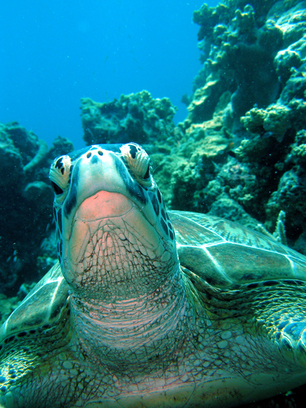
I will never forget my first sight, as a small child, of a live green sea turtle. It was swimming in a heated tank in Regents Park Zoo in London and its slow, graceful action as it circled and weaved in the water was quite mesmerising.
I did not realise then that I would one day be living where green turtles nested on the beaches and where the annual adventure of the tiny hatchlings paddling their way to the sea took place. New born, they run the gauntlet of natural danger with predators such as gulls and crabs lined up to take them. Despite these hazards, many make it although, since most hatchings are at night, on the more populated beaches they are also often distracted by lights. Many a beachside swimming pool owner has found baby turtles in the pool following a night time hatch.
As turtle watcher Henry Epong of Cowley Beach described it, “They reach the water and swim out and every now and then raise their heads to look ahead to where they are going and I always think, it will be 35 years before you are here again. It is an amazing thought.”
There is so much mystery surrounding turtles.
How do they navigate huge distances, migrating through the warmer waters of the world, to find their way back to exactly the same beach where they were hatched to lay their eggs?
Why are there some good years for turtle hatchings and on other years no turtles appear?
What is happening to the sea turtles in these changing times, with global warming and increasing pollution of the oceans?
The International Union for the Conservation of Nature (IUCN) first identified the green turtle as endangered in 1982, and the species numbers are still falling.
One reason must be the damage to the sea grass beds fed on by the herbivorous adults. Not only cyclones and other water disturbances cause damage to these underwater meadows which locally are also grazed by dugong.
They are often badly damaged by trawling, buried or otherwise disturbed during development, and polluted by weedicide residues and other agricultural and urban runoff.
It is also well known turtles, which need air to breathe, drown in fishing nets and die from ingesting plastic bags, and added to the turtles’ maritime dangers, in some places eggs are taken by predators such as wild pigs, or simply squashed when unthinkingly driven over by 4WDs.
This season turtles began nesting on Cowley Beach in September, earlier than usual. Some nests were lost, but the first nest yielded 114 young, and about 1000 baby turtles were counted from the beach in all. Only a very few, of course, will make it through the hazards encountered over 35 years or so to come back and lay. No turtles have been seen on the beach since Cyclone Yasi.
The cyclone has also subtly rearranged the beach by taking away about a metre depth of sand from the dune, making it easier for the turtles to climb.
So if nothing changes in the meantime, next year’s turtles will not have such a challenging journey to find their nesting sites.
+++
With the advent of dryer weather making it easier to burn fallen trees and other green waste collected into piles or windrows following Cyclone Yasi, please spare a thought for the creatures which may be seeking refuge in them.
Give wildlife a go, literally, and burn carefully so they have a chance to escape before the fire takes hold. If the fire is being started by fuel on the perimeter, leave plenty of space so that any creatures inside can get out.
Nocturnal animals, especially, are in danger at this time as they would be sleepy and if the fire is set in the evening, this is the time when daytime creatures are settling down to rest.

Phone DERM on 1300 130 372 to report concerns about cassowaries and mahogany gliders.
Lawrie Martin and Anne Wilkinson write wildlife articles which are featured each week in the Tully Times. They have kindly given permission for them to be a regular post on this blog.

